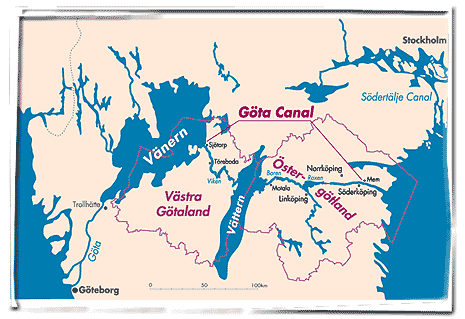| |
The Göta Canal in Sweden, like the Canal du Midi, was for
centuries a dream before it became reality. The connection between
the vast Lake Vänern and the Baltic would only be of value for
trade if navigation were possible between the lake and the Göta
river downstream of the Trollhätte falls. Thus efforts were concentrated
initially on by-passing these falls. Engineer Nordewall designed
and implemented from 1790 a remarkable project, which is not unlike
that imagined by Leonardo da Vinci to by-pass the Adda rapids
at Paderno: a canal dug in the rock beside the falls, with two
flights of locks (here 5 and 3 chambers). The success of this
canal, inaugurated in August 1800, encouraged the Count Baltzar
von Platen to take off the shelf the plan drawn up in 1781-84
for a canal right across Sweden from east to west, and submit
it once again to the approval of King Gustav IV.
Von Platen had been informed of the similar project for the Caledonian
Canal, then being built by engineers Jessop and Telford. At von
Platen's invitation, Telford spent six weeks during the summer
of 1808 working on detailed layout of the canal and siting of
the locks, with more and shallower locks than proposed in the
earlier project. Their dimensions, 32 m by 7 m, are slightly smaller
than those of the Scottish canal.
Work started in 1810 under Samuel Bagge, with troops made available
by the government as navvies. The canal was opened on September
24, 1822, one month earlier than the Caledonian. Sadly, von Platen
did not live to see completion of his project. (He died in 1819.)
Begun of course before the steamboat era, the Göta proved too
small to be commercially successful, especially after railways
added their competition and tolls through the Sound were ended
in 1857. However, visitors today can still pass through in passenger
ships that run a summer service. The cruise across Sweden, taking
three days, is a well-established tourist product.
The whole line is 558km long from Gothenburg to Stockholm, of
which 97km is man-made. After the Göta river and the Trollhätte
Canal comes Lake Vänern; then the Göta Canal proper from Sjötorp
on the far side of Lake Vänern through Lakes Vättern and Roxen
to Mem on the Baltic, whence ships pass through an archipelago
into a fjord. From here the 3.2km Södertälje Canal (opened 1819)
leads into Lake Mälaren, and so to Stockholm.

There are 65 locks in all, and a summit-level 93m above sea level.
The 7-rise staircase at Berg can be compared with the 8-rise at
Banavie on the Caledonian, and the earlier 8-rise (now 6-rise)
at Fonsérannes (Béziers) on the Canal du Midi.
|
|



